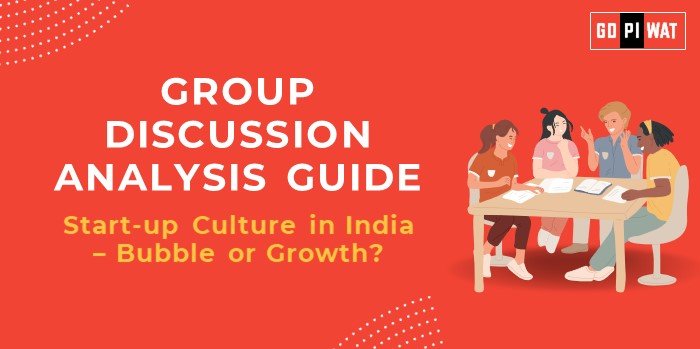📋 Group Discussion Analysis: Start-up Culture in India – Bubble or Growth?
🌐 Introduction to Start-up Culture in India
- India’s start-up ecosystem ranks among the top globally, driven by entrepreneurship and innovation.
- Key debate: Is the Indian start-up boom sustainable growth or a speculative bubble?
- The journey accelerated post-2014, with initiatives like Start-up India and strong venture capital inflows.
- Challenges include valuation bubbles, burn rates, and scalability concerns.
📊 Quick Facts and Key Statistics
- 🌱 Number of Start-ups: Over 127,000 start-ups recognized by DPIIT as of April 2024.
- 🦄 Unicorns Count: Third globally with a collective valuation of $349.67 billion as of May 2024.
- 📈 Funding Trends: $7 billion raised in H1 2024, compared to $5.92 billion in H1 2023.
- 💼 Employment Impact: Over 1.2 million direct jobs created by start-ups.
- 🏛️ Government Support: Initiatives like ₹10,000 crore Fund of Funds under Start-up India.
👥 Stakeholders and Their Roles
- 🏛️ Government: Policy implementation and easing compliance for innovation.
- 💰 Investors: Venture capital and angel funding for growth and guidance.
- 🌟 Entrepreneurs: Innovating new business models and strategies.
- 🤝 Incubators: Providing mentorship, funding, and networks for start-ups.
- 🛍️ Consumers: Driving market demand through adoption and feedback.
🏆 Achievements and ⚠️ Challenges
✨ Achievements:
- 🦄 Unicorn Boom: Over 100 unicorns by 2022.
- ✅ Government Support: Regulatory ease fostering innovation.
- 🌍 Global Recognition: Start-ups like Zomato and Byju’s gaining international acclaim.
- 📈 Sector Diversity: Strong presence across ed-tech, fintech, health-tech, and more.
⚠️ Challenges:
- 🔍 Valuation Bubble: High valuations without proportionate revenues.
- 🔥 Cash Burn Rates: Difficulty achieving profitability.
- 📉 Funding Crunch: Dip due to global economic factors.
- 🌐 Global Comparisons: Regulatory bottlenecks and market access challenges.
💡 Case Study: Byju’s faced criticism for financial management issues amidst rapid expansion.
💬 Structured Arguments for Discussion
- ✅ Supporting Stance: “India’s start-up boom has catalyzed innovation, job creation, and global recognition.”
- ⚠️ Opposing Stance: “Unsustainable business models and funding challenges threaten long-term growth.”
- 🤝 Balanced Perspective: “Growth is noteworthy but must address scalability and operational inefficiencies.”
🧠 Effective Discussion Approaches
- 📌 Opening Strategies:
- Highlight India’s rise in unicorns and economic contributions.
- Contrast rapid growth with funding slowdowns.
- Use examples of successful exits versus failures.
- 🎯 Counter-Arguments: Acknowledge valuation concerns while emphasizing successful pivots and need-based growth.
🔍 Strategic Analysis: SWOT Framework
- ✨ Strengths: Government support, youth population, sector diversity, global investor interest.
- ⚠️ Weaknesses: High cash burns, valuation excess, regulatory hurdles.
- 🚀 Opportunities: Emerging tech adoption, global expansions, collaboration with traditional industries.
- ⚡ Threats: Market corrections, economic downturns, global competition.
🎓 Connecting with B-School Applications
- 📘 Real-World Applications: Case studies in strategy, financial modeling, and market entry.
- 💭 Sample Interview Questions:
- “Do you see the current Indian start-up scenario as a bubble?”
- “What role should VCs play in balancing growth versus profitability?”
- 💡 Insights for Students: Strategies for sustainable growth, analyzing market-entry barriers, and understanding valuations.


